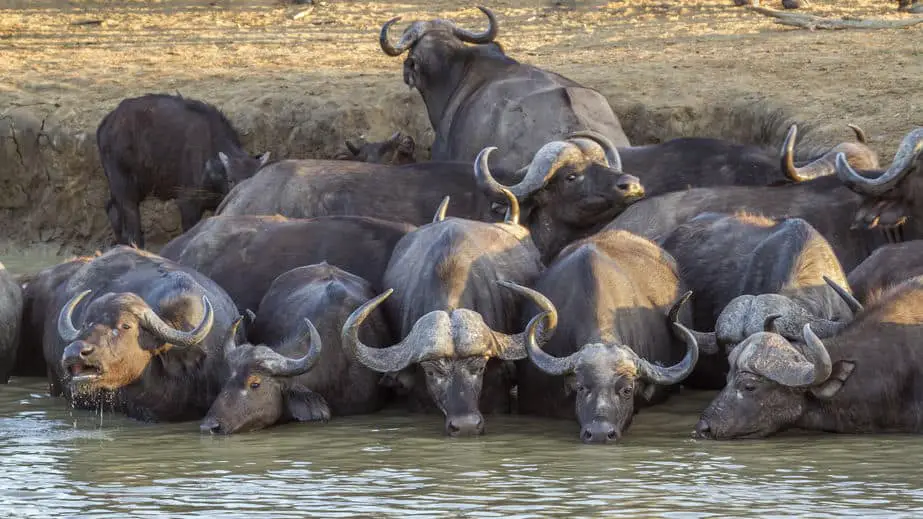
The African buffalo, or Cape buffalo, is a very large animal and is known to be the most dangerous member of the big five. But just how big are Cape buffalos?
At birth, Cape buffalo calves weigh 66-132 lb (30-60 kg). Fully grown Cape buffalo bulls weigh between 1100-2000 lb (around 500-900 kg) and the cows weigh between 770-1370 lb (around 350-620 kg). Cape buffalos measure up to 5.7 feet (175 cm) in height at the shoulders.
Despite what many people think, Cape buffalos are among the most dangerous animals of Africa and part of what makes them so dangerous is their massive size and their aggressive personality. Below I have covered just exactly how big Cape buffalos can get including how large their primary weapon, the horns are, and how large the calves are at birth.
How Big is a Fully Grown Cape Buffalo?
Cape buffalos are very large animals and one of the major advantages they benefit from is their size.
Their massive size increases their ability to defend themselves from attacking predators such as lions and will actually often make predators think twice before attacking and perhaps even make them search for a different prey animal that is smaller and easier to overpower than a Cape buffalo since a Cape buffalo is not only difficult to overpower for predators but also extremely dangerous.
A fully grown Cape buffalo male (called a bull) weighs between 1100-2000 lb (around 500-900 kg) and a fully grown Cape buffalo female (called a cow) weighs between 770-1370 lb (around 350-620 kg).
They measure between 4.9 to 5.7 feet (about 150 to 175 cm) in height at the shoulders and between 5.6 to 11.2 feet (1.7 to 3.4 meters) in length, not including the tail. The tail adds an extra 28 to 43 inches (70 to 110 cm) to those numbers.
Cape buffalos are not only very large animals but they are also extremely strong and they are built in a way that makes them very dense and bulky.
On top of that, Cape buffalos are known for having a very unreliable personality and can often behave aggressively and completely unpredictable.
The fact that they are so massive and large and also have such an unreliable and aggressive personality and temper make them extremely dangerous. Not only for predators but also for humans.
In fact, Cape buffalos are believed to be responsible for more human deaths per year than any other African mammal with an estimated 200 human deaths on their conscience. This is one of the reasons why they are a member of the so-called Big Five which is the five large mammals of Africa that are widely perceived as being the most dangerous ones to hunt on foot. The other members of the big five are elephants, leopards, lions, and rhinoceroses.
How Big is a Baby Cape Buffalo?
After a gestation period of between 11 and 11.5 months, a Cape buffalo cow will give birth to a calf. They will almost always give birth to just a single calf but in some rare cases, they have been observed giving birth to twins.
A newborn Cape buffalo calf is small and helpless and quite adorable. At birth, a Cape buffalo calf weighs between 66 and 132 lb (around 30 to 60 kg). It will learn to walk and to seek out food from its mother quickly and will soon grow to become a huge beast like the rest of the herd.
Cape buffalos reach sexual maturity around the age of 3 to 5 years.
How Large are the Horns on a Cape Buffalo?

One of the most characteristic and most easily recognizable features of a Cape buffalo is its horns. They are large and thick and have a curved shape which can be seen in the image above.
The largest Cape buffalo horn ever recorded measured an impressive 64 inches (163 cm) and belonged to a female.
On a fully grown Cape buffalo bull, the massive horns meet at the middle on top of the forehead of the bull where they form an extremely hard and thick shell that works almost like a defensive shield that protects this critical area of the bull’s head. This area is called the boss and is extremely useful for the bull, especially when it comes to fights with other bulls.
Cape buffalo females do not have a boss as it does not provide value from them from an evolutionary perspective.
When Cape buffalo bulls fight, they will slowly back up and then charge directly towards each other at full speed and bang their thick bosses against each other. This clash can be so intense and forceful that the weaker bull can sometimes be thrown several meters through the air.
These bullfights are a way for them to determine which of the bulls is the strongest. The strongest bull will be higher in the hierarchy of the herd and will also attract more females.
How Large are Cape Buffalo Herds?
Cape buffalos are highly social creatures and will almost always stay with their herd which is usually made up of between 10 to 20 of them.
The females are at the center of these herds and a herd will most often consist of around 10 to 15 females who are all related to each other and their calves and then around 4 to 5 bulls following them around.
Sometimes, however, Cape buffalo bulls will stick to small groups with only a few other bulls and no females or calves and only seek out the females during mating season.
Sometimes you can be very lucky and see some massive herds of Cape buffalos consisting of several thousand animals. These giant herds are temporary and will usually be formed especially during mating season and for long wanderings.
Traveling together in such high numbers can provide the Cape buffalos with additional safety and protection from predators.
These giant herds of Cape buffalos can have as many as 2000 to 3000 members and are truly a magical and almost unbelievable sight.
Why is the Cape Buffalo so Dangerous?
Cape buffalos are widely accepted as being the most dangerous member of the big five.
There are several things that make Cape buffalos so dangerous but the primary thing is definitely their personality which can be fierce, aggressive, and completely unpredictable.
Cape buffalos are believed to be responsible for around 200 humans deaths per year. The primary victims are big-game hunters who are caught by an angry Cape buffalo that has managed to sneak up on the unsuspecting hunter by hiding in dense vegetation or tall grass.
If wounded a Cape buffalo will often try to get behind the hunter and sneak up on him or her before charging to get revenge. Unlike elephants, Cape buffalos do not mock charge and once they have started charging, they are almost impossible to stop and will do what they can to kill their target.
Cape buffalos are not only extremely dangerous towards humans and are also believed to be responsible for more lion deaths than any other animal.
Lions also pose a very big threat towards Cape buffalos, however, and can especially be deadly when they hunt as a group. When lions hunt as a group, they can overpower and take down animals up to 10 times larger than themselves including fully grown Cape buffalos. In some parts of Africa, Cape buffalos even make up one of the most important sources of food for lions.
Cape buffalos and lions is an age-old rivalry with no end in sight.
